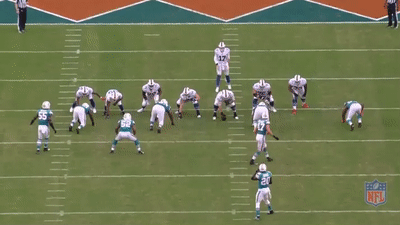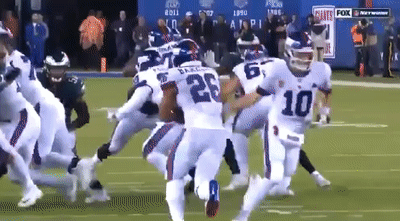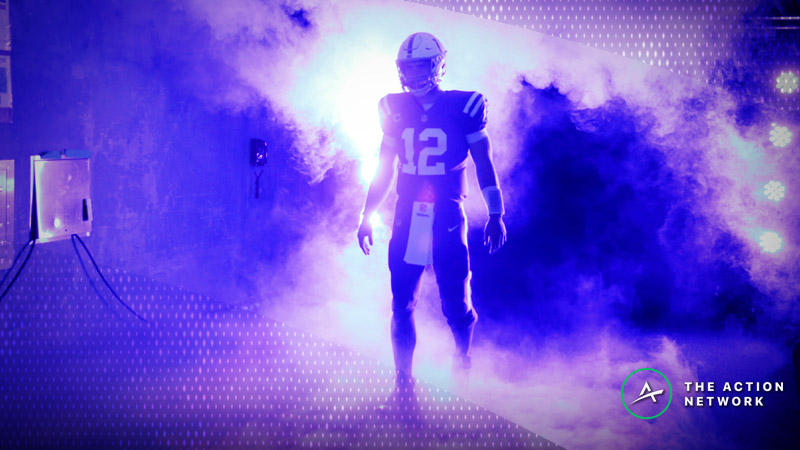The NFL is a matchup-driven league. Offensive coordinators are always looking to scheme their playmakers into one-on-one situations against a defender, while defensive coordinators will attempt to do anything in their power to upset the timing and rhythm of the opposing quarterback.
Despite the obvious impact that defenses have on opposing offenses, fantasy players are often left with one-way metrics to describe offenses and defenses that they are then forced to compare against each other in an attempt to identify mismatches.
The goal here is to provide easy-to-decipher charts and notes to identify each week’s key matchups on both sides of the ball in:
- Explosive Plays
- Pace
- Pressure
- Trench Battles
- Turnover Margin
- Passing Game
Last week’s manifesto correctly forecasted underwhelming performances for Jameis Winston and Jared Goff, solid rushing days for Joe Mixon and Justin Jackson as well as an uber-efficient passing performance from Kirk Cousins.
The following charts display matchup-specific information meant to highlight the largest mismatches in these ever-important facets of football to ultimately gain actionable betting and fantasy takeaways.
Note: This data is based on games from Weeks 1-15.
Explosive Plays
Big plays make the football world go round. Matchups between explosive offenses and leaky defenses are exactly what we’re looking for when compiling game stacks in DFS, or when betting an over. We can calculate this with help from NFL.com’s team-based statistics.
- Explosive Pass Rate: The sum of an offense’s rate of 20-plus yard completions per pass attempt and the opposing defense’s rate of 20-plus yard completions allowed per pass attempt. A higher percentage is better for offenses (green is good, red is bad).
- Explosive Run Rate: The sum of an offense’s rate of 20-plus yard gains per rush attempt and the opposing defense’s rate of 20-plus yard runs allowed per rush attempt. A higher percentage is better for offenses (green is good, red is bad).
- Saturday and Sunday afternoon aren’t expected to feature many fireworks in the passing game. The only games with the right combination of explosive passing attacks against porous secondaries are the Chiefs-Seahawks and Broncos-Raiders matchups.
- Additional pass offenses that could create some big plays includes the Chargers, Browns, Texans, Rams and Saints.
- Baker Mayfield and the Browns in particular have been playing at a very high level in the post-Hue Jackson era.
Baker Mayfield with Freddie Kitchens calling plays (6 starts):
4-2, 71% cmp rate, 8.7 Y/A, 1,594 pass yards, 13 TDs, 5 INTsDeshaun Watson in 6 starts as a rookie:
3-3, 63% cmp rate, 8.8 Y/A, 1,597 pass yards, 18 TDs, 7 INTs— Ian Hartitz (@Ihartitz) December 17, 2018
- The Dolphins stand out as the least-favorable passing attack against Jalen Ramsey and the Jaguars.
- Additional offenses that could struggle to create explosive plays in the passing game include the Redskins, Ravens, Lions, Eagles and Giants.
- The Bills-Patriots and Bears-49ers matchups feature two offenses that could struggle to create big plays through the air. The over/under in each game has dropped since opening (per our Live NFL Odds Page).
- Run games that are set up particularly well to bust some big gains include the Packers, Panthers, Giants and Chiefs.
- Jamaal Williams will certainly benefit from the absence of Aaron Jones (knee, IR), as well as the confirmed presence of Aaron Rodgers under center. Williams has 19, 15, 25, 25 and 22 touches in his last five games with Jones sidelined.
- Rushing attacks that might struggle to create explosive plays this weekend include the Redskins, Titans, Ravens, Buccaneers, Lions, Eagles and Saints.
Pace
Fast-paced games lead to more plays, which lead to more points. There are several games that could resemble a track meet based on their combined situation-neutral pace ranking (Football Outsiders).
- Combined Situation-Neutral Pace: Represents the combined situation-neutral pace between each matchup’s two offenses. A lower number indicates fewer average seconds per play (green = fast-paced game), while a higher number indicates more average seconds per play (red = slow-paced game).
- There isn’t a single matchup between two teams with a top-10 situation neutral pace rank this week.
- Week 16’s projected fastest-paced matchups features the Giants (No. 17 in situation neutral pace) and Colts (No. 1) as well as the Bills (No. 18) and Patriots (No. 2).
- Historically, T.Y. Hilton (ankle, questionable) has embraced the Colts’ fast-paced offense inside the friendly confines of Lucas Oil Stadium more than most.
T.Y. Hilton career per-game indoors (68 games):
5.1 receptions, 85.4 yards, 0.47 TDs, 38% games with 100+ yardsHilton per-game outdoors (44 games):
4.2 receptions, 61.2 yards, 0.23 TDs, 20% games with 100+ yardsNext up: Giants' 32nd-ranked defense in DVOA vs No. 1 WRs in Indy
— Ian Hartitz (@Ihartitz) December 18, 2018
- Be sure to monitor our Week 16 Injury Report for Hilton’s daily practice participation along with his estimated and official game status.
- Ravens-Chargers, Bengals-Browns, Buccaneers-Cowboys, Rams-Cardinals and Steelers-Saints also have a chance at more closely resembling a track meet than a football game.
- The week’s three slowest matchups feature the Redskins (No. 32) and the Titans (No. 25), the Vikings (No. 19) and Lions (No. 31) as well as the Jaguars (No. 24) and Dolphins (No. 30).
- These three games have the week’s three-lowest over/unders.
- Additional games with the potential for a generally slower pace of play include the Packers-Jets, Texans-Eagles and Falcons-Panthers.
Pressure
An overmatched offensive line can result in poor fantasy days for all skill-position players involved. Meanwhile, quarterbacks with all day to throw can help generate points in bunches. We can determine which offensive lines might be especially better (or worse) this week with help from Pro Football Focus’ offensive and defensive pressure statistics.
- Combined Pressure Rate: The sum of the offensive line’s rate of pressures allowed per dropback and the opposing defense’s total pressures generated per dropback. A higher percentage (red) is better for defenses, while a lower percentage (green) indicates that matchup’s quarterback could face reduced pressure.
- As usual, Deshaun Watson is the quarterback most at risk of being suffocated by pressure. The Texans (44%) join the Cardinals (41%) as the only teams that have allowed a pressure on at least 40% of their dropbacks.
- This problem could be further pronounced this Sunday against an Eagles defensive line (52% pressure rate) that joins the Vikings (54%), Jaguars (52%), Rams (52%), Ravens (50%), Bills (50%) and Jets (50%) as the only defenses with a pressure rate of at least 50%.
- Additional quarterbacks that could face routine pressure this week include Josh Rosen, Ryan Tannehill, Josh Allen and Sam Darnold.
- Per Justin Bailey, Allen has been pressured on 51% (!!!) of his dropbacks since Week 12, but sacked on just 8.2% of them. If we only accounted for rushing production, Allen would be the league’s RB5 between Weeks 12 and 15 behind only Derrick Henry, Joe Mixon, Phillip Lindsay and Saquon Barkley.

- The Patriots are one of just 10 defenses that have allowed at least 250 rushing yards to quarterbacks this season, making Allen a solid streaming option in wake of Cam Newton’s (shoulder, out) injury.
- Matchups featuring capable pass rushes on both sidelines include Packers-Jets and Jaguars-Dolphins.
- Case Keenum is expected to be kept clean against the Raiders’ embarrassing defense that has tallied a pressure on a league-low 26% of their opponent’s dropbacks. The Browns boast the league’s second-worst pass rush, but are at least all the way up to 38%.
- Additional quarterbacks that aren’t expected to be overwhelmed by pressure include Jeff Driskel, Taylor Heinicke, Andrew Luck, Jared Goff, Ben Roethlisberger and Drew Brees.
- Any DFS stacks with Roethlisberger should probably be focused with Antonio Brown or Juju Smith-Schuster as opposed to both. Per our NFL Pro Models, AB and Smith-Schuster carry a -0.54 correlation in DraftKings points per game: They don’t typically have strong performances together.
Percentage of snaps spent in the slot + PFF rank for each Saints CB:
Marshon Lattimore – 6% and No. 24 CB
Eli Apple – 7% and No. 65 CB
P.J. Williams – 76% and No. 106 CB
…
Juju Smith-Schuster slot rate: 64%— Ian Hartitz (@Ihartitz) December 18, 2018
Trench Battles
Running backs receive most of the praise for an offense’s rushing output, but an overmatched offensive line can thwart a team’s run game before it even has a chance to get started. We can determine the offensive lines that might be especially better (or worse) off this week with help from Football Outsiders‘ offensive and defensive adjusted line yards per rush statistics.
- Combined Adjusted Line Yards Per Rush: The sum of an offensive line’s adjusted line yards per rush and the opposing defense’s adjusted line yards allowed per rush. A higher number (green) is good for running backs, while a lower number (red) indicates that matchup’s offense could have some trouble running the ball.
- Christian McCaffrey, Todd Gurley and Chris Carson stand out as the running backs with the best matchups at the line of scrimmage this week. Note: CMC’s workload could theoretically be curtailed considering they’re already sitting Newton. Of course, this will also likely result in McCaffrey boasting low tournament ownership.
- Gurley (knee) is considered day-to-day, but head coach Sean McVay said the expectation is that he’ll play Sunday. John Kelly is positioned to work as the offense’s featured back if Gurley is ultimately unable to suit up, although the Rams did sign C.J. Anderson earlier this week.
- Additional rushing attacks that are set up well include running backs from the Titans, Browns, Colts, Saints and Broncos.
- Peyton Barber, Josh Adams, Tevin Coleman and Saquon Barkley stand out as the running backs with the worst matchups.
- Still, Barkley’s big-play ability and monstrous workload make him matchup proof. The dude is ridiculous.

- Coleman’s tough matchup should also be granted some more leeway than usual considering Ito Smith (knee, IR) is done for the season and the Falcons are now favored vs. the Newton-less Panthers.
- Additional backfields that aren’t set up particularly well include the Redskins, Bengals, Jets, Texans, Dolphins, Bears, 49ers and Steelers.
- Of course, workload is more important than matchups when evaluating running backs for fantasy, and we’ve seen a wide variety of featured backs in recent weeks.
Week 15 RBs that played 70%+ snaps (not including MNF)
These guys make sense:
Saquon Barkley 100%
Ezekiel Elliott 88%
Todd Gurley 83%
Matt Breida 73%Lmao:
Jamaal Williams 87%
Alfred Blue 77%
Justin Jackson 76%
Eli McGuire 75%
Damien Williams 73%
Derrick Henry 70%— Ian Hartitz (@Ihartitz) December 17, 2018
Turnovers
Matchups between two careless teams are obviously of interest when it comes to targeting fantasy defenses. Crafting a turnover differential for each individual matchup between an offense and defense can help identify when turnover-prone offenses are taking on ball-hawking defenses.
- Combined Turnover Rate: The sum of the offense’s turnover rate and the opposing defense’s takeaway rate. A higher percentage (red) is better for defenses, while a lower percentage (green) is better for offenses and indicates the absence of a turnover-prone offense or takeaway-happy defense.
- The Chargers boast the week’s best advantage in combined turnover rate because they’ve done a solid job at taking care of the ball, and only the 49ers (5 takeaways) have been worse at forcing turnovers than the Ravens (11) this season.
- Additional offenses that aren’t expected to make too many careless mistakes include the Texans, Bears, Saints, Seahawks, Broncos and Packers.
- Defenses that could thrive against their turnover-happy opponent are headlined by the Rams and Bears against Josh Rosen and Nick Mullens, respectively. They’re the league’s only two defenses that have created a turnover on at least 3% of their opponent’s plays.
- Home defenses that are best positioned to create some takeaways include the Cowboys, Browns, Patriots, Dolphins and Saints.
- The Steelers are obviously a different monster than most offenses, but the Saints deserve plenty of credit for allowing 17 or fewer points in six consecutive games.
Passing Game
Some pass offenses are obviously more efficient than others, while certain secondaries are seemingly capable of shutting down any aerial attack. We can determine the week’s largest mismatches in the passing game using each offense’s and defense’s net yards per pass attempt (via Pro Football Reference).
- Combined Net Yards Per Pass Attempt: Net yards gained per pass attempt differs from yards per attempt by accounting for sacks. The rate is calculated by subtracting a quarterback’s sack yards from his passing yards, then dividing that number by the sum of the quarterback’s pass attempts and sacks taken. A higher number (green) is good for quarterbacks and receivers, while a lower number (red) indicates that matchup’s pass offense could be in trouble.
- Patrick Mahomes stands out as the quarterback best positioned to shred their opponent’s secondary. The Seahawks’ impressive defense has waned lately, and none of their starting cornerbacks — Justin Coleman (PFF’s No. 48 CB), Tre Flowers (No. 65) nor Shaquill Griffin (No. 109) — should be feared.
- James Winston also stands out as a quarterback potentially set up well. The Cowboys certainly boast a talented defense, but they’ve been a slight pass funnel unit considering they rank fifth in DVOA against the run and 14th against the pass.
- Additional quarterbacks that could find some aerial success include Matt Ryan, Ben Roethlisberger, Drew Brees and Case Keenum.
- Matchups featuring more a potentially fantasy-friendly combination of competent quarterbacks and mediocre secondaries includes Bucs-Cowboys, Texans-Eagles, Steelers-Saints and Broncos-Raiders.
- Josh Johnson, Matt Stafford (back), Josh Allen, Sam Darnold, Ryan Tannehill and Josh Rosen boast the week’s worst combined net yards per pass attempt rates.
- Stafford’s status in particular will be interesting to watch considering he’s been listed as questionable for the last two weeks, the Lions have nothing to play for, and running back Kerryon Johnson (knee) was just placed on the injured reserve list.
- Matchups that could feature porous pass offenses on both sidelines include Redskins-Titans, Bills-Patriots, Jaguars-Dolphins and Bears-49ers.
- Thanks for reading and good luck in championship week!



